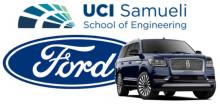Design of a Duct for Additive Manufacturing Economics
Background
Conventional manufacturing methods, such as injection molding, can be expensive when it’s being used for low volume (< 20,000 units) production. Since tooling is not universal and must be altered to fabricate various parts, traditional manufacturing methods can lead to high upfront tooling costs. However, additive manufacturing, also called 3D printing, provides users a range of advantages that include the following: flexibility in design, printing on demand, rapid prototyping, and cost effectiveness.
There are various types of additive manufacturing methods available, and for this project, we will be using multi-jet fusion (MJF) technology to redesign an automotive air duct for Ford. MJF provides users the ability to nest parts which maximizes the number of parts per print job, resulting in lower unit costs. With this printing technology, Design for Additive Manufacturing (DFAM) principles will be used to produce innovative designs that will reduce costs for Ford’s low volume production projects.
Goals and Objectives
We will be following the Engineering design process to implement multiple designs that will minimize the unit cost and maintain similar performance to a traditionally manufactured automotive air duct. We will be providing 3 designs with a business case for each one outlining the advantages over traditional manufacturing to Ford by the end of the Spring 2021 quarter.
How Multi-Jet Fusion 3D-Printing Works
The printer first deposits a layer of material on the build platform. In one single pass, the fusing agent is applied on the layer of material where particles need to fuse, then detailing agent is applied to modify fusing and create fine detail and smooth surfaces. Lastly, to finalize creating the cross-sectional area of the part, energy is applied so that the reactions between the agents and material can happen. This process is repeated layer by layer until the final product is completed.
Progress
By leveraging design for additive manufacturing principles, we were able to develop four unique duct designs that are optimized for nesting efficiency which lowers the unit cost. The duct designs include the following: snap fits, book style, telescoping, and separated walls. Each design implements different locking mechanisms in order to keep separate parts together once fully assembled.
Numerous prototypes were developed and printed using UCI’s HP 4200 MJF printer in order to test the various designs. With feedback from our advisor and sponsor, we were able to finalize our duct designs. Subsequently, we created business cases which analyzed the opportunities available for additive manufacturing economics.
To view some of the printed prototypes and additional details, please refer to the video titled “Spring Video".
Future Recommendations
We were able to lower unit costs for most of our designs for low volume production, however, there is still more work to be done. Some recommendations for future work include: testing the printed duct to verify the fit with the local assembly, selecting a method to seal gaps between parts in order to minimize air leakage, and improving the design to allow better airflow through the duct.
Team Contacts
Edward James Pedro (ejpedro@uci.edu)
Omid Souri (osouri@uci.edu)
Elizabeth Suarez (suareze2@uci.edu)
Anil Verman (averman@uci.edu)
Sponsor
Siddarthan Selvasekar (sselvase@ford.com)
Advisor
Benjamin Emerson Dolan (dolanb@uci.edu)

